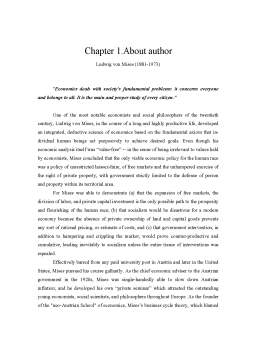Cuprins
- Chapter1. About the author
- Chapter2. Introduction
- Chapter3. The capitalism
- Chapter4. The socialism
- Chaptre5. Foreigner investment
- Chapter 1.About author
Extras din proiect
Ludwig von Mises (1881-1973)
"Economics deals with society's fundamental problems; it concerns everyone and belongs to all. It is the main and proper study of every citizen."
One of the most notable economistvs and social philosophers of the twentieth century, Ludwig von Mises, in the course of a long and highly productive life, developed an integrated, deduct¬ive science of economics based on the fundamental axiom that in¬dividual human beings act purposively to achieve desired goals. Even though his economic analysis itself was “value-free” -- in the sense of being irrelevant to values held by economists, Mises concluded that the only viable economic policy for the human race was a policy of unrestricted laissez-faire, of free markets and the unhampered exercise of the right of private property, with government strictly limited to the defense of person and property within its territorial area.
For Mises was able to demonstrate (a) that the expansion of free markets, the division of labor, and private capital investment is the only possible path to the prosperity and flourishing of the human race; (b) that socialism would be disastrous for a modern economy because the absence of private ownership of land and capital goods prevents any sort of rational pricing, or estimate of costs, and (c) that government intervention, in addition to hampering and crippling the market, would prove counter-productive and cumulative, leading inevitably to socialism unless the entire tissue of interventions was repealed.
Effectively barred from any paid university post in Austria and later in the United States, Mises pursued his course gallantly. As the chief economic adviser to the Austrian government in the 1920s, Mises was single-handedly able to slow down Austrian inflation; and he developed his own “private seminar” which attracted the out¬standing young economists, social scientists, and philosophers throughout Europe. As the founder of the "neo-Austrian School" of economics, Mises’s business cycle theory, which blamed inflation and depressions on inflationary bank credit encouraged by Central Banks, was adopted by younger economists in England in the early 1930s as the best explanation of the Great Depression.
Having fled the Nazis to the United States, Mises did some of his most important work here. In over two decades of teaching, he inspired an emerging Austrian School in the United States. The year after Mises died in 1973, his most distinguished follower, F.A. Hayek, was awarded the Nobel Prize in economics for his work in elaborat¬ing Mises’s business cycle theory during the later 1920s and 1930s.
Socialism-communism had triumphed in Russia and in much of Europe during and after World War I, and Mises was moved to publish his famous article, “Economic Calculation in the Socialist Commonwealth,” (1920) in which he demonstrated that it would be impossible for a socialist planning board to plan a modern economic system; furthermore, no attempt at artificial “markets” would work, since a genuine pricing and costing system requires an exchange of property titles, and therefore private property in the means of production.
Mises’s influence was remarkable, considering the unpopularity of his epistemological and political views. His students of the 1920s, even those who later became Keynesians, were permanently stamped by a visible Misesian influence. These students included, in addition to Hayek and Robbins, Fritz Machlup, Gottfried von Haberler, Oskar Morgenstern, Alfred Schutz, Hugh Gaitskell, Howard S. Ellis, John Van Sickle, and Erich Voegelin
Chaptre2.Introduction
“The capitalism and its enemy” represent the analyses of big economic problems witch modern society meet. Ludwig von Mises try to response at some questions like: What is the capitalism? Why it appear? What are the consequences?
Preview document
Conținut arhivă zip
- The Capitalism and Its Enemy by Ludwig von Mises.doc












